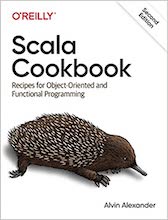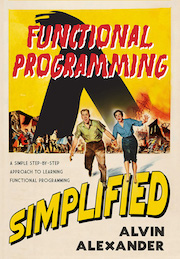This is an excerpt from the 1st Edition of the Scala Cookbook (partially modified for the internet). This is Recipe 11.4, “How to Delete Elements from a List (or `ListBuffer`) in Scala”
Problem
You want to delete elements from a Scala List or ListBuffer.
Solution
A List is immutable, so you can’t delete elements from it, but you can filter out the elements you don’t want while you assign the result to a new variable:
scala> val originalList = List(5, 1, 4, 3, 2) originalList: List[Int] = List(5, 1, 4, 3, 2) scala> val newList = originalList.filter(_ > 2) newList: List[Int] = List(5, 4, 3)
Rather than continually assigning the result of operations like this to a new variable, you can declare your variable as a var and reassign the result of the operation back to itself:
scala> var x = List(5, 1, 4, 3, 2) x: List[Int] = List(5, 1, 4, 3, 2) scala> x = x.filter(_ > 2) x: List[Int] = List(5, 4, 3)
See Chapter 10 for other ways to get subsets of a collection using methods like filter, partition, splitAt, take, and more.
ListBuffer
If you’re going to be modifying a list frequently, it may be better to use a ListBuffer instead of a List. A ListBuffer is mutable, so you can remove items from it using all the methods for mutable sequences shown in Chapter 10. For example, assuming you’ve created a ListBuffer like this:
import scala.collection.mutable.ListBuffer val x = ListBuffer(1, 2, 3, 4, 5, 6, 7, 8, 9)
You can delete one element at a time, by value:
scala> x -= 5 res0: x.type = ListBuffer(1, 2, 3, 4, 6, 7, 8, 9)
You can delete two or more elements at once:
scala> x -= (2, 3) res1: x.type = ListBuffer(1, 4, 6, 7, 8, 9)
That method looks like it takes a tuple, but it’s actually defined to take two parameters and a third varargs field.
You can delete elements by position:
scala> x.remove(0) res2: Int = 1 scala> x res3: scala.collection.mutable.ListBuffer[Int] = ListBuffer(4, 6, 7, 8, 9)
You can use remove to delete from a given starting position and provide the number of elements to delete:
scala> x.remove(1, 3) scala> x res4: scala.collection.mutable.ListBuffer[Int] = ListBuffer(4, 9)
You can also use --= to delete multiple elements that are specified in another collection:
scala> val x = ListBuffer(1, 2, 3, 4, 5, 6, 7, 8, 9) x: scala.collection.mutable.ListBuffer[Int] = ListBuffer(1, 2, 3, 4, 5, 6, 7, 8, 9) scala> x --= Seq(1,2,3) res0: x.type = ListBuffer(4, 5, 6, 7, 8, 9)
Discussion
When you first start using Scala, the wealth of methods whose names are only symbols (+:, /:, :::, etc.) can seem daunting, but the -= and --= methods are used consistently across mutable collections, so it quickly becomes second nature to use them.
See Also
- Recipes 10.17 through 10.19 show many ways to filter collections (filtering is a way of deleting)
- Recipe 10.3, “Choosing a Collection Method to Solve a Problem”
| this post is sponsored by my books: | |||

#1 New Release |

FP Best Seller |

Learn Scala 3 |

Learn FP Fast |